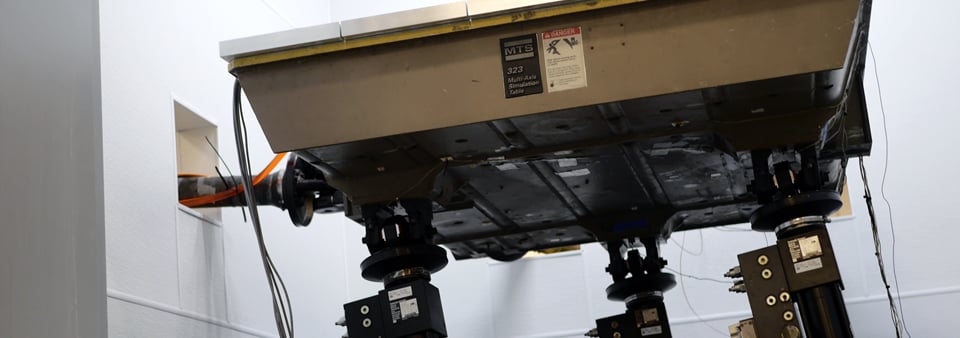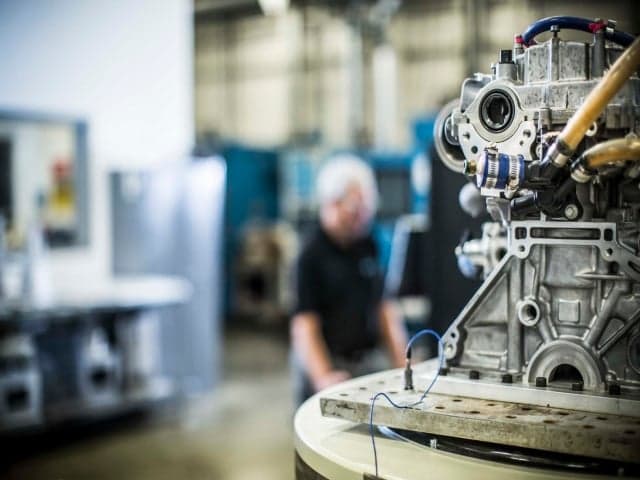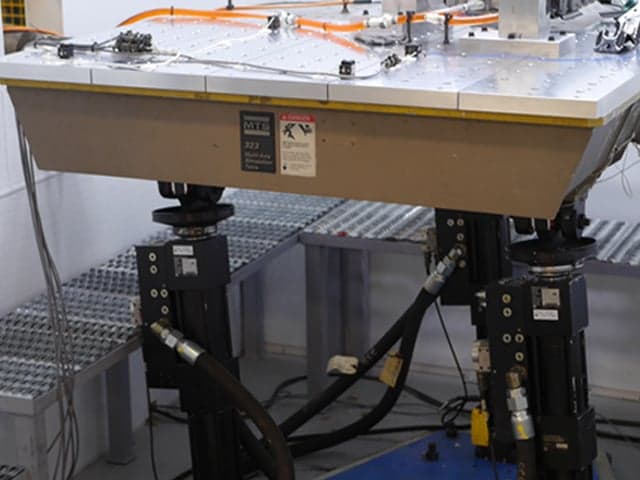What is Multi-Axis Simulation Table (MAST) Testing and What are its Automotive Applications?
In this article, Element's experts demonstrate how Multi-Axis Simulation Table (MAST) testing revolutionizes automotive component validation by replicating lifetime wear in just weeks using servo-hydraulic actuators with 6 degrees of freedom. This guide reveals how RLDA-driven testing delivers faster, more precise results than proving grounds, accelerating time-to-market while ensuring component durability.
Multi-axis simulation table testing (sometimes also called multi-axial simulation testing or multi-axis shaker table testing) uses a platform fitted with servo-hydraulic actuators to subject a component or assembly to vibration, shaking, tilting, and similar forces. Typically, this testing is performed to understand how an automotive component or sub-system will respond to these forces in the real world. The forces applied to the vehicle or component during MAST testing are not random, the table can be programmed with incredible precision to move in the specific patterns desired for testing. For vehicle components, assemblies, and sub-systems, the type, frequency, intensity, and duration of the forces exerted by the table are based on data collected from road load data acquisition (RLDA), a process that measures a vehicle’s response to road input as it is tested on a proving ground.
Depending on what data the customer requires, automotive MAST testing can be performed in conjunction with or in place of proving ground testing. There are many advantages to using MAST testing to gather data about vehicle components, and there are many cases in the automotive industry where MAST testing is preferable to testing on a proving ground.

How does a multi-axis simulation table work?
A multi-axis simulation table (MAST) is a flat, rigid surface connected to multiple servo-hydraulic actuators. In Element’s case, for vehicle component testing, we typically use five or six actuators that move individually to provide 5 or 6 degrees of freedom, including lateral, longitudinal and vertical translation as well as pitch, roll and yaw rotations, based on inputs provided by a computer program.
The MAST relies on a programmed drive file, or actuator input. The customer may supply a predesigned drive file that they use as their testing standard, but in many cases, road response data is collected from vehicles driving on road surfaces, using an array of vehicle-mounted sensors. The raw response data is analyzed and edited, and key data from the proving ground test is used to create the drive file. A drive file, essentially, tells the MAST input actuators how to move to precisely recreate the forces from the proving ground test. Drive file development is an iterative process that relies on accurate data, specialized computer programs, and the expertise of testing professionals to give accurate, relevant, and repeatable results.
Experts edit the data to retain only damaging events, then use that data to create a drive file. They test it many times to ensure that the MAST generates the correct forces and recreates damage and fatigue accurately. Once the drive file is created and validated, vehicle components can be attached to the MAST surface and tested many times with the same sequence of inputs.
What are the advantages of automotive MAST testing?
MAST testing does not fully replace proving ground testing, but when it comes to testing components, assemblies, and sub-systems in particular, it is faster, more cost-effective, and more precise than repeating proving ground tests on an assembled vehicle. It allows components to be tested and evaluated individually, rather than testing an entire vehicle, and it allows testing professionals to isolate variables and diagnose problems or issues in a component more precisely than they could on a proving ground. The MAST can repeat exactly the same series of movements over and over in a way that would be impossible for a driver on a track, which is a reliable way of comparing the performance of multiple different designs of the same component or isolating the cause of a failure.
MAST testing also reduces overall testing time, which reduces time to market. By selecting and repeating only the most damaging forces from the proving ground test over and over, MAST testing can replicate the lifetime wear on a component in a time frame as short as a few weeks, reducing the testing time for an individual component significantly. Additionally, when components are small, multiple components can be affixed to a single MAST, allowing them to be tested simultaneously.
What are the limitations of automotive MAST testing?
MAST testing relies on RLDA data from a proving ground to be successful, so effective testing relies heavily on quality data collection and interpretation. The expertise of the testing professionals involved can be a significant factor in data reliability, as editing the raw data and creating the drive file are manual processes that require firsthand experience and extensive testing knowledge.
A physical limitation of MAST testing is the rigid table surface, which does not allow for twisting or bending, which may be a necessary part of testing for certain components. The size and weight of the component or assembly are also important to consider. MASTs come in a range of sizes and weight limits; some can accommodate an entire vehicle while others have a surface only a foot across; some actuators have a force capacity of 500 lbs., while others have a 77,000 lb. capacity. When you evaluate a prospective testing partner, it is important to understand the scope of your requirements and to assess whether the testing lab’s equipment can meet those needs.
If you have questions about how MAST testing is performed or how MAST testing from Element could benefit your organization, please reach out to speak with one of our experts. With a long history of automotive industry testing experience and a global family of laboratories, we have the capacity, knowledge, and equipment to help you reach your goals.
Related Services

Automotive Testing Services
Accelerate automotive testing with Element’s end-to-end services. Ensure compliance, validate performance & reduce development time from components to full vehicles.

Vibration Testing Services
Ensure your product's safety and durability. Element's advanced vibration testing services replicate real-world scenarios, revealing potential issues before they occur. Learn More.

Multi-Axial Simulation Table (MAST) Testing Services
Element's MAST testing replicates real-world vibrations in a controlled lab, helping automotive engineers assess durability, reduce development time, and refine vehicle components for safer, more reliable performance.





